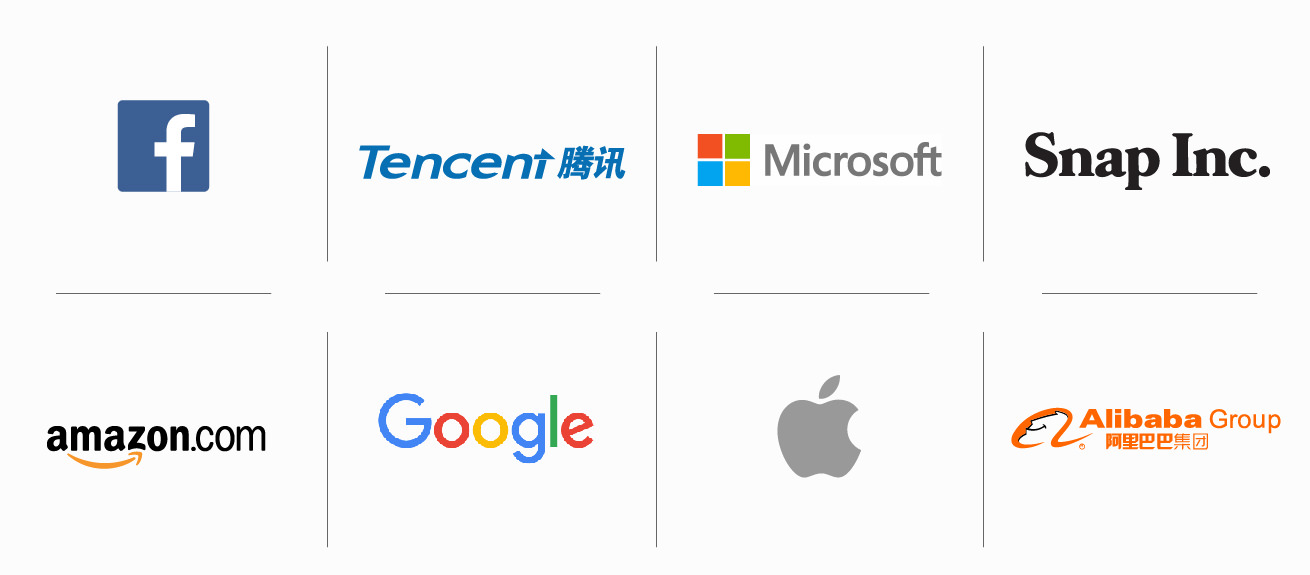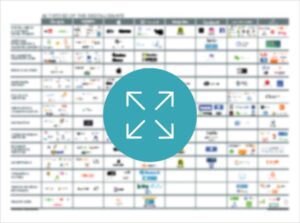
In mid-2017, we released a summary of the activities of 8 of the world’s largest digital giants, namely Google, Amazon, Facebook, Apple, Microsoft, Snap, Alibaba, and Tencent. We tracked their activities across 13 areas, including digital content and media, A.I. and machine learning, online commerce, offline commerce, hardware devices, IT and cloud services, messaging and communications, navigation, business services, financial services, advertising, operating systems, and browsers.
It was clear then that, despite each company having its own original areas of focus, they were starting to converge. We witnessed a high degree of overlap in product and service areas and an increasing amount of direct competition among them. For instance, Alibaba and Tencent had expanded from their origins in ecommerce marketplaces and social media respectively, to actively compete with each other across a wide range of activities, including IT services, payments, and digital media. Amazon, Microsoft, and Google had moved aggressively into B2B cloud services. Practically all the giants were starting to experiment with hardware devices and offline services.
We recently updated the research and found that the pace of convergence had quickened – they were looking more alike than ever. But, they were also expanding into new areas.
Harvest: How the giants have been building on their strengths
Most of the giants have been expanding from their base areas of strength to encroach on others, not only on the other giants, but also on the territory of adjacent players. For example, Facebook announced the launch of a new dating service for meeting non-friends. This in-app feature was designed to cut out the middle men like Tinder and Match.com.
Facebook was also actively addressing its so-called teen problem – it is reported that the social media giant has been losing young users for years, with many going to Snapchat– by adding many of Snapchat’s most popular features to Instagram.
Google (re)launched YouTube Music, a streaming service that is designed to compete with Spotify, Amazon Music, and Apple Music. Meanwhile, Apple purchased music and image recognition service Shazam.
While the Western giants have been active acquirers, the bigger action has been happening in China. Alibaba’s founder Jack Ma stated many times that Alibaba was an ecommerce enabler rather than an ecommerce company, but, based on recent activity, that claim has become harder to justify. In the last year, Alibaba has launched its own private label marketplace, Taobao Xinxuan, literally meaning selection by heart. Under its “New Retail” strategy, Alibaba has also expanded its presence in brick and mortar stores, including Hema shop, a fresh food focused supermarket that aims to merge online and offline shopping, and Taocafe, an unmanned shop. They have even built a vending machine for cars!
Tencent, already the dominant player in Chinese social media, added many more features to its twin platforms – Wechat and QQ. Wechat added financial services and mini-apps, that together meet almost any consumer need. As a result, users have increased their time on Wechat – an average time of 66 minutes per day. Tencent also increased its interest in gaming, by purchasing a 5 percent stake in Ubisoft, a French video game publisher.
Disrupt: How the giants are entering new spaces – healthcare
The giants have not been content to merely build on their considerable strengths. They have been expanding into new areas, the most notable of which is healthcare.
Earlier his year, Amazon made a surprise announcement that it would enter the healthcare arena in partnership with JPMorgan Chase and Berkshire Hathaway. It is not yet clear what that will do together, but merely the announcement of intent sent shockwaves through the sector.
Amazon was not alone in targeting healthcare. Apple announced a plan to launch its own medical clinics for employees. In addition, Apple Heart Study was designed to find irregular heart rhythms via Apple Watch, and Apple Health was launched to manage health records. Microsoft, too, was ramping up its health business with Healthcare NeXT, a healthcare services drawing on Microsoft’s cloud services.
Not to be outdone, Google acquired Senosis Health, a company focused on monitoring health conditions via smartphones. Its life-science research unit, Verily, also made a number of key investments in the health insurance market.
The Chinese giants may be ahead of their Western peers. Alibaba and Tencent have been increasingly active in the healthcare space. Both companies have invested heavily in medical startups. Last summer, Alibaba unveiled a service for medical image diagnosis of CT scans, called Doctor You. The software can read 9,000 scans in 30 minutes with a more than 90% accuracy rate in detecting lung sarcoidosis, perceived as an important early indicator of cancer[5]. Tencent released a similar diagnostic medical imaging service called Miying at about the same time. The company recently announced that healthcare would become one of its three core strategies of A.I. this year.
The next wave of disruption – A.I.
All the digital giants have been actively investing in A.I., both through internal development and acquisition. Indeed, A.I. acquisitions were up 44% in 2017 and seem to be maintaining that trend in 2018. Many of the largest deals were made by the digital giants. Google, Amazon, Facebook, Microsoft, and Apple made 14 A.I. acquisitions between them since the middle of 2017. According to KPMG, venture capital investments in A.I. doubled to US$12 billion in 2017.
Three years ago, Amazon’s A.I. powered Amazon Echo digital assistant was a mysterious novelty. Today, almost all the digital giants have their own versions of it: Google has Google Home, Microsoft has Invoke, Alibaba has Tmall genie, and as a late mover, Apple launched its HomePod in February. Amazon is not resting on its laurels – earlier this year it purchased smart doorbell company, Ring.
Today, all the digital giants are investing heavily in A.I. capabilities. Google even changed its focus from ‘mobile first’ to ‘A.I. first’. However, once again, it may be the Chinese who have the lead. Almost half of all global investments in A.I. came from China, and many of these were led by Alibaba and Tencent[9]. The world’s largest A.I. computers are based in China and Chinese companies are outpacing the West in A.I. related patents and publications.
Research Information & Knowledge Hub for additional information on IMD publications
The case explores TBC Bank Group’s remarkable journey from a small Georgian bank to a regional leader in digital financial services across Central Asia. Founded in 1992 with just US$500 in initial capital, TBC evolved into Georgia’s largest financ...
The case describes two transformation journeys for ABN AMRO bank. The first transformation is cultural and the second is digital. It explores the interplay between these two journeys from the perspective of the head of the Personal Banking. The ca...
As uncertainty grows, organizations must rethink how they navigate a volatile world. Rather than relying solely on scenario planning based on historical data, organizations could take a more proactive approach—imagining and shaping distant futures...
A great way for executives to hone their communication skills is by having a coach listen in on their conversations and provide feedback. But given the increasing capability of AI-based tools to have meaningful conversations with people, research...
The China Resources Beer (CR Beer) case study is a compelling narrative of the world’s largest beer producer by volume under the leadership of CEO Hou Xiaohai. In 2016 CR Beer embarked on a pivotal transformation journey. This case study offers cr...
Five friends created DIDA in 1983 and turned it into a global provider of IT infrastructure and services. Riding the wave of rapid growth of communication networks and increasingly global business relationships of corporations, DIDA established it...
Research Information & Knowledge Hub for additional information on IMD publications
Research Information & Knowledge Hub for additional information on IMD publications
Research Information & Knowledge Hub for additional information on IMD publications
Research Information & Knowledge Hub for additional information on IMD publications
The case describes two transformation journeys for ABN AMRO bank. The first transformation is cultural and the second is digital. It explores the interplay between these two journeys from the perspective of the head of the Personal Banking. The ca...
in Forbes.com 20 February 2025
Research Information & Knowledge Hub for additional information on IMD publications
Research Information & Knowledge Hub for additional information on IMD publications
Research Information & Knowledge Hub for additional information on IMD publications
Research Information & Knowledge Hub for additional information on IMD publications
NTT Corporation, Japan’s information and communication technologies (ICT) leader since 1953, was the first to commercialize internet usage on mobile phones in the 1990s, which resulted in NTT achieving much success in Japan. However, by the end of...
Building on NTT (A), the case starts with NTT’s CEO having narrowed down strategic growth options with the board to prepare NTT for the future. Past international investments in AT&T Wireless and KPN to tap into foreign markets had resulted in bil...
Research Information & Knowledge Hub for additional information on IMD publications
in I by IMD Brain Circuits 15 January 2025
Research Information & Knowledge Hub for additional information on IMD publications






